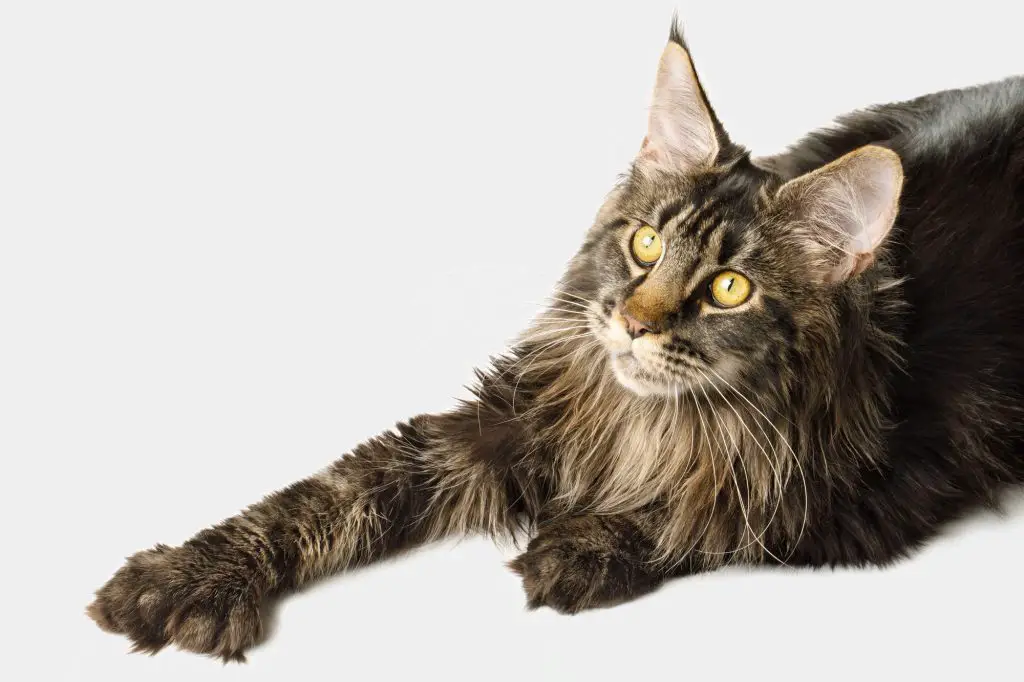You may be wondering what all this talk is about a Maine Coon with extra toes, a condition referred to as “polydactyly”. While it’s not completely unique to the Maine Coon breed, polydactyly is seemingly more common in Maine Coons than other cats.
For many Maine Coons this means having just a sixth toe on one or more of their feet, but some polydactyl Maine Coons have been recorded to have seven or even eight extra toes!
Maine Coon breeders have mostly bred out the trait for polydactyly, but it’s thought that if the trait was not removed from the breed approximately 28% of Maine Coons would be polydactyl.
Are There More Health Risks for Polydactyl Maine Coons?
Although it’s an unusual trait, polydactyly is typically harmless and does not affect the overall health of the Maine Coon. In fact, some Maine Coon experts claim that polydactyl Maine Coons are overall more hardy and healthy than the standard Maine Coon. Whatever the case may be, you can expect a perfectly normal and lovable Maine Coon regardless of their number of toes.
What Causes Polydactyly in a Maine Coon
Polydactyly is caused by a mutation in the gene responsible for paw digit formation, called the “Hemingway mutation”, named after the fact that the famous author had a polydactyl cat.
This genetic mutation is not dominant, meaning it’s fairly easy for breeders to avoid it by making sure one Maine Coon parent does not have the gene.
The Hemingway mutation not only causes a Maine Coon to have extra toes, but can lead to enlargement of the dew claw, making it more like a thumb. Some Maine Coons only have extra toes on one paw, while others might have extra toes on all their paws.
Having an extra thumb-like digit is referred to as having “mittenpaws” while having extra non-thumb-like digits is referred to as “pattyfeet”.
Why Polydactyl Maine Coons Came About

The origins of genetic mutation for polydactyly in Maine Coons isn’t completely understood, but there is some speculation why it stayed about in Maine Coons and not other cats.
Maine Coons were originally ship cats that kept the ships traveling between the East Coast of the US and Europe free of mice and rats. It’s thought that the extra toes were an advantage in climbing and hunting, and the close inbreeding on these ships did not effectively get rid of gene mutations like diverse breeding would.
These polydactyl ship Maine Coons were considered lucky by sailors, so there might have been some additional help in selective breeding by the sailors themselves.
It’s also thought that polydactyl Maine Coons had an advantage walking on snow in the frigid Northern environment of Maine. The extra toes make their feel extra wide, making it easier to “float” on top of the snow without sinking in.
Popularity of Polydactyl Maine Coons
Polydactyl Maine Coons have been made a lot less common by selective breeding to avoid the trait in litters, but in recent decades the extra-toed trait has become more popular among Maine Coon enthusiasts. Some breeders even specialize now in breeding for the trait so they can supply the niche demand for these highly sough after kittens, and the practice has become controversial.
Regardless, polydactyl Maine Coons are accepted within breeding standards of all the major cat registries and fully recognized as purebreds.
You can find a list of TICA-approved polydactyl Maine Coon breeders here.
Hemingway’s Polydactyl Cats
Ernest Hemingway the famous author of “A Farewell to Arms” and “The Old Man and the Sea”, among many other novels, had a polydactyl cat named Snow White that was gifted to him by the captain of a ship. Although Hemingway has long passed, his house still remains in Key West, Florida, and is filled with about 40-50 polydactyl cats, most of which are descendants of Snow White.














